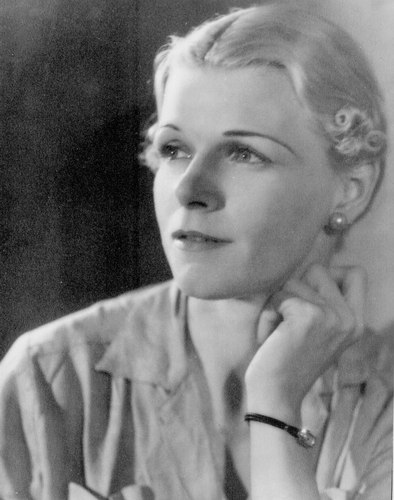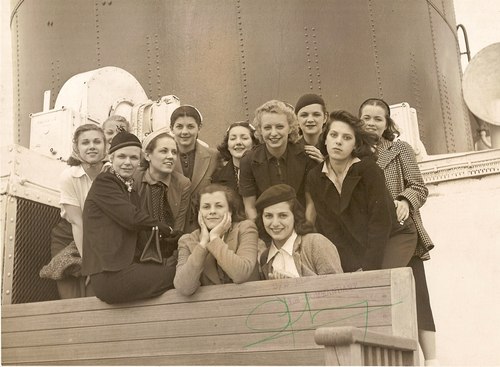|
 |
|
|
 |
 |
Okay, balletomanes: What is the oldest continuously functioning ballet company in the United States? Right: The Atlanta Ballet, founded in 1929, by Dorothy Alexander, as the Dorothy Alexander Concert Group. So, that was easy. Now, here's a harder one: What was the first American ballet company to tour Europe? I'll give you a hint: it was also the first American ballet company to produce an evening-length (three-act) version of The Sleeping Beauty, which deployed 100 dancers and employed 85 musicians. Need another hint? Its affiliated school—which, evolved in the latter 1920s—supplied George Balanchine with his first core group of dancers when he established the School of American Ballet and choreographed Serenade, in 1934. The lady in the back row got it right. It was the company that was founded in Philadelphia, Pennsylvania, in 1935, by the dancer and choreographer Catherine Littlefield (who had studied in Philadelphia with several teachers and in Paris with Léo Staats and Lubov Egorova) and her mother, Caroline. Known at different times as the Littlefield Ballet, the Philadelphia Ballet, and the ballet troupe of the Chicago City Opera, the company lasted until 1941, when it had to cancel a second European tour because its complement of male dancers resigned to enlist in the War effort. While the organization lasted, though, it was a family affair, with matriarch Caroline installed as director, daughter Catherine as dancer and resident choreographer, daughter Dorothie (whom Balanchine had hired in 1934 to teach the junior division of SAB) as principal dancer, and son Carl as a dancer. Both sisters died relatively young. Dorothie, 1912-1953, went on to perform Balanchine's choreography with the Ballet Russe de Monte Carlo in the Broadway show Song of Norway and to dance in other Broadway shows, as well as theatrical shows on ice that her sister choreographed and for which Dorothie served as assistant choreographer. Many of Sonja Henie's ice shows were choreographed by Catherine, 1905-1951, who also choreographed for musical theater and television ("The Jimmy Durante Show"). Her American Jubilee, for the New York World's Fair of 1940, was "a dance for 90 bicycles," presumably steered by 90 bicyclists. Like Lincoln Kirstein's Ballet Caravan and the Balanchine-Kirstein American Ballet, the Philadelphia (or Littlefield) Ballet was a short-lived product of the amazing dance energy pouring from the Middle Atlantic States during the 1930s and into the 1940s—an energy that also produced the Atlanta Ballet, Ballet Theatre, the San Francisco Ballet, the Martha Graham Dance Company, and many other modern dance companies and groups, some of which survive today. One thread connecting their repertories was an emphasis on Americana themes and folk or popular material, from the 1935 Yale football ballet, Alma Mater, Balanchine's second creation in America, after Serenade, for the American Ballet; to the 1940 Léonide Massine work The New Yorker (based on the magazine's cartoons), with a Gershwin score, and Agnes de Mille's 1942 Rodeo, to an Aaron Copland score based on cowboy tunes, both for the Ballet Russe de Monte Carlo—a company that, after 1939, never performed in Europe, only in America; to Martha Graham's 1944 Appalachian Spring, with a Copland score that features the American hymn "Simple Gifts." By the latter half of the 1930s, the Philadelphia Ballet was also concentrating on Americana, and in several senses. In 1937, its repertory novelties, by Catherine Littlefield and other choreographers, included the ballets Barn Dance (revived by Ballet Theatre, in 1944), Parable in Blue (a "symphonic-jazz" ballet), The Rising Sun (a ballet about the history of Philadelphia), and Let the Righteous Be Glad, and the company prided itself on the fact that its dancers, choreographers, composers, and scenic designers were practically all American citizens. In 1939, while maintaining ties to its Philadelphia audiences, the Littlefield or Philadelphia Ballet became the official ballet company in residence at the Chicago Civic Opera. On the way to that position, Catherine Littlefield choreographed two satirical ballets for the Chicago opera company in 1938— Ladies' Better Dresses, a spoof of fashion; and Café Society, a spoof of nightclubs, which seems to have been part of a larger cultural payback to Clare Boothe Luce. (The term "café society"—coined by the first "Cholly Knickerbocker" columnist, Maury Paul, and made famous by the journalist Lucius Beebe to refer to aspiring socialites who frequented nightclubs—seems to have been used by Luce in such a disparaging way that other figures struck back as well. Among them was Barney Josephson, who, the same year as Littlefield's ballet was given its world première in Chicago, founded the ironically named nightclub Café Society in Greenwich Village, advertised as "the wrong place for the right people," to promote African American singers and musicians. According to Wikipedia, it was the first racially integrated nightclub in the United States.) Toward the end of its life, the Littlefield company brought Café Society to Philadelphia and then toured it through the U.S. Once the company folded, however, the ballet was extinguished with it. As for its commissioned score, by Ferde Grofé, the last recorded performance of that as a concert piece was in Philadelphia, in 1942, by the Pennsylvania W.P.A. [Works Projects Administration] Orchestra. The last, that is, until this month. For a single performance—a Sunday matinee at the intimate, warm, Bauhaus-inspired Perelman Theater of Philadelphia's Kimmel Center—the Philadelphia Sinfonia, an orchestra of students, who play under the baton of conductor Gary D. White, gave a concert whose second half featured the Grofé music, painstakingly reconstructed and accompanied by a documentary film that showed snippets of Catherine Littlefield's ballet. In a brief email exchange with me, Sharon Skeel—Catherine Littlefield's biographer—wrote: "I actually own the original piano reduction score of Café Society, marked up extensively with Littlefield's notes. Last summer, I showed it to Gary White, who was interested in having Philadelphia Sinfonia perform it. We then searched around for the orchestral parts and found them in the Fleisher [Collection, at the Philadelphia Free Library], the only place in the world that has them. Purely by chance, Kile Smith, the curator at the Fleisher, has a daughter in Sinfonia, and, for a while, she and my son shared a stand. Both play the cello. The film footage I already knew about, having obtained a research copy of it from the Newberry [Library, in Chicago] years ago." The entire Sinfonia program consisted of Franz Schubert's Rosamunde Overture, D. 644; the Polovetsian Dances from Alexander Borodin's opera Prince Igor; and, in the second half, Grofé's Café Society, accompanied by a documentary about the period and the ballet, featuring some of the archival footage that Ms. Skeel had seen at the Newberry. From where I was seated, the screen was positioned too high for me to study the dance portions of the film; however, one could, indeed, glimpse something of the dancers' technique, which includes strong (if not ideally shaped) legs and feet and very strong backs. One fleeting image of a ballerina in an exacting arabesque allongée made me wonder if I was seeing Dorothie Littlefield, whose fluency and physical rightness for classical dancing were noted from the time she was a small child. Inclusion of this film was a very wise idea, indeed, both as a service to the work and to us, the contemporary audience, since Grofé's score—although obliging in every possible way (divided into self-contained, rhythmically driven numbers, many based on dance rhythms, and dotted with humor and such descriptive sounds as a cab whistle and a drum roll), is, as my companion for the afternoon put it, a period piece. That is—at least, on one hearing—the orchestration and fillips of real-life sounds are more arresting than the actual musical material. In a number of passages, I was brought up short by how much the score evoked the concert works of George Gershwin. Only when I got back home that evening, and did a little research, did I discover how appropriate the evocation is. Grofé is most well-known today for his orchestral work the Grand Canyon Suite, with its astonishingly apt musical "pictures" of such sounds as the protesting wail of a pack mule, which stubbornly resists getting started up a steep trail. However, much of his career was not as a composer, per se, but rather as an orchestrator, most prominently for Paul Whiteman, the conductor who commissioned Gershwin to write Rhapsody in Blue and whose band presented it to the world for the first time in 1924. It turns out, though, that what Gershwin gave Whiteman was a two-piano version, which had to be orchestrated. And the orchestrator was Grofé, who went on to make several more orchestrations of the work in his career. Grofé, one of the pallbearers at Gershwin's funeral, was a tremendous fan of GG's music, and it would be strange if his ballet score for Littlefield—written in service to a scenario that drew on Gershwin's characteristic themes in his early work of charm, social dancing, and bright young things enjoying their nightlife—didn't carry some of Gershwin's voice. Still, I'd like to hear it again and wish that the Philadelphia Sinfonia had been able to manage more than one performance of it. Incidentally, those students—drawn from junior high and high schools, as well as institutions of higher education, from all over the city—were models of instrumental devotion, and very good musicians, too, thanks, surely, to the leadership and discipline provided by Maestro White. Their intonation was extremely careful (never have I encountered before an orchestra that tunes up for at least three minutes before every selection it plays), and their conductor kept their pace consistent. In the Borodin "Polovetsian Dances"—incidentally, a score associated not only with Diaghilev's Ballets Russes but also with the Littlefield Ballet, which produced a ballet called Prince Igor, by Alexis Dolinoff—was beautifully played, with sure tempi and a fine array of orchestral color. What a pleasure to see so many young persons working together on a mission of delivering art works from the past in pristine condition. When the concertmaster-first violinist, a lovely teenaged girl of poise and dignity, surprised Maestro White with a huge bouquet from the orchestra, the heartfelt gesture—and his unscripted delight—touched the entire house.
 Catherine Littlefield
Courtesy of Catherine Littlefield Flaherty Photo © & courtesy of Unknown |
|
 Catherine, Dorothie and other Philadelphia Ballet Company dancers aboard the Ile de France in May 1937 on their way to Europe
Courtesy of Ward Littlefield Photo © & courtesy of Unknown |
|
|
|



